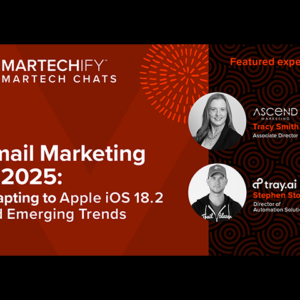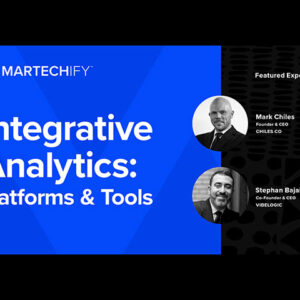Precision Marketing: How BluLogix Wins by Targeting the Right Customers with Surgical Accuracy
- Inga Broerman, Head of Sales & Marketing at BluLogix
- AI and Automation, Campaign Optimization, Content Strategy and Marketing, Customer Experience (CX), Data Management and Analytics, Digital Transformation, Lead Gen / Lead Mgmt
Most marketing teams are throwing darts in the dark, hoping something sticks. What if you could turn those wild guesses into precision-targeted strategies that actually convert?
We interviewed Inga Broerman and we’re honored to bring you her thoughts on precision marketing strategies.
Inga is Head of Sales & Marketing at BluLogix, a company that provides a specialized billing platform for complex business transactions. With a background in operations, sales engineering, and marketing, she brings a well-rounded perspective to customer targeting and engagement.
BluLogix delivers a sophisticated billing solution built for companies with highly specific and intricate needs. Rather than relying on broad marketing tactics, Inga focuses on precision—identifying and connecting with the right customers through targeted, strategic outreach.
We interviewed Inga Broerman and we’re honored to bring you her thoughts on precision marketing strategies.
Inga is Head of Sales & Marketing at BluLogix, a company that provides a specialized billing platform for complex business transactions. With a background in operations, sales engineering, and marketing, she brings a well-rounded perspective to customer targeting and engagement.
BluLogix delivers a sophisticated billing solution built for companies with highly specific and intricate needs. Rather than relying on broad marketing tactics, Inga focuses on precision—identifying and connecting with the right customers through targeted, strategic outreach.
Check out the full interview with Inga Broerman, where she shares how BluLogix wins with precision marketing—from building a laser-focused ICP to using multi-touch attribution to track what really drives revenue. If you’re done chasing vanity metrics and ready to market smarter, not louder, this one’s for you.
Combining focused targeting with a data-driven marketing approach
Inga combines the power of a laser-focused ideal customer profile (ICP) with a data-driven approach to marketing.
Once she’s decided on the exact customer—with their unique set of pains, needs, and technical requirements—and engineered a strategy for targeting them, she then focuses on tracking, measuring, and tweaking the execution to turn marketing into a predictable process.
This combination of precise targeting and meticulous data collection around the customer journey makes Inga Broerman’s approach so uniquely effective.
Once she’s decided on the exact customer—with their unique set of pains, needs, and technical requirements—and engineered a strategy for targeting them, she then focuses on tracking, measuring, and tweaking the execution to turn marketing into a predictable process.
This combination of precise targeting and meticulous data collection around the customer journey makes Inga Broerman’s approach so uniquely effective.
The power of a laser-focused ICP
Inga starts with her ICP. At BluLogix, they don’t target an entire industry, but rather a specific set of attributes within that industry.
As Inga explains, “It wasn’t necessarily an industry that needed us. It was a specific set of components within that industry that needed us.”
Their ICP includes companies that:
— Sell through channel partners
— Sell bundled goods
— Operate in regulated industries (typically communications)
— Have complex data requirements like usage-based billing
“If somebody is doing one or two of those four things, that is just a huge win for us,” Inga notes.
This approach contrasts sharply with traditional agency advice of generating massive lead volumes.
Inga recalls past campaigns that generated 40,000 leads but ultimately created more problems than opportunities. “40,000 leads are hard to sift through,” she candidly admits. “If you’re running an SDR team, that’s not a success.”
As Inga explains, “It wasn’t necessarily an industry that needed us. It was a specific set of components within that industry that needed us.”
Their ICP includes companies that:
— Sell through channel partners
— Sell bundled goods
— Operate in regulated industries (typically communications)
— Have complex data requirements like usage-based billing
“If somebody is doing one or two of those four things, that is just a huge win for us,” Inga notes.
This approach contrasts sharply with traditional agency advice of generating massive lead volumes.
Inga recalls past campaigns that generated 40,000 leads but ultimately created more problems than opportunities. “40,000 leads are hard to sift through,” she candidly admits. “If you’re running an SDR team, that’s not a success.”
Inga’s personal experience as a prospect
But after identifying the ICP—and devising a go-to-market strategy to target the segment—Inga’s big focus is on how the data tells the story about what buttons and levers to push to get a marketing result.
In fact, her marketing philosophy is deeply influenced by her own experiences as a martech prospect. She shares a personal story of being pursued by a sales representative for five years.
“I downloaded every white paper they ever sent. I went to every webinar that they ever did,” she recounts. The sales rep left voicemails consistently for five years, never getting a response. Then suddenly, when her boss needed the product, she contacted that rep immediately.
This experience taught her a critical lesson about marketing: impact isn’t always immediately measurable. The multiple touchpoints—white papers, webinars, website visits—contributed to the eventual sale, even if traditional attribution models would miss them.
In fact, her marketing philosophy is deeply influenced by her own experiences as a martech prospect. She shares a personal story of being pursued by a sales representative for five years.
“I downloaded every white paper they ever sent. I went to every webinar that they ever did,” she recounts. The sales rep left voicemails consistently for five years, never getting a response. Then suddenly, when her boss needed the product, she contacted that rep immediately.
This experience taught her a critical lesson about marketing: impact isn’t always immediately measurable. The multiple touchpoints—white papers, webinars, website visits—contributed to the eventual sale, even if traditional attribution models would miss them.
Identifying critical touchpoints that lead to sales
At BluLogix, tracking prospect interactions is a meticulous process. Inga’s approach goes beyond traditional single-touch attribution models, embracing a multi-touchpoint strategy that captures the complexity of the buyer’s journey.
“We do a multi-touchpoint attribution model that essentially pulls all of the different things they touched,” Inga explains.
This multi-touchpoint attribution model can include:
— ABM impressions
— LinkedIn engagements
— Other digital interactions
Her team carefully maps out the entire customer interaction landscape. For some customers, this means tracking 50 touchpoints before an opportunity emerges and 100 touchpoints after.
The goal isn’t just to count interactions, but to understand their significance. “We can apportion out that revenue across all of those touchpoints and see what it looks like,” Inga notes.
This approach helps BluLogix avoid the common pitfall of celebrating vanity metrics. Inga recalls past experiences where marketing teams would get excited about large lead volumes, only to discover these were just “empty calorie” leads.
This multi-touchpoint attribution model can include:
— ABM impressions
— LinkedIn engagements
— Other digital interactions
Her team carefully maps out the entire customer interaction landscape. For some customers, this means tracking 50 touchpoints before an opportunity emerges and 100 touchpoints after.
The goal isn’t just to count interactions, but to understand their significance. “We can apportion out that revenue across all of those touchpoints and see what it looks like,” Inga notes.
This approach helps BluLogix avoid the common pitfall of celebrating vanity metrics. Inga recalls past experiences where marketing teams would get excited about large lead volumes, only to discover these were just “empty calorie” leads.
Using regression analysis to map the buyer journey
Inga’s background in operations gives her a unique perspective on data analysis. She references a fascinating example from her time at Siemens, where HP demonstrated using regression analysis to measure TV advertising effectiveness.
“They did basically a big testing scenario where they would ramp advertising in different cities, then drop it the next week,” she explains. This allowed them to precisely measure advertising impact across various dimensions.
While Inga modestly claims she can “theoretically” do regression analysis, her approach is fundamentally about understanding cause and effect. “Being able to understand if I ramp up my LinkedIn spend and have a gazillion impressions, what’s that going to do a week down the line?” is her guiding principle.
“They did basically a big testing scenario where they would ramp advertising in different cities, then drop it the next week,” she explains. This allowed them to precisely measure advertising impact across various dimensions.
While Inga modestly claims she can “theoretically” do regression analysis, her approach is fundamentally about understanding cause and effect. “Being able to understand if I ramp up my LinkedIn spend and have a gazillion impressions, what’s that going to do a week down the line?” is her guiding principle.
Connecting precision measurement with targeted marketing
BluLogix’s marketing strategy hinges on economic efficiency and precise targeting. Inga emphasizes that the era of indiscriminate spending is over. “It isn’t the heyday of spending $12,000 to acquire one customer anymore,” she notes.
Her approach focuses on creating a hyper-specific marketing ecosystem:
— Understand exact customer needs
— Build trust through authentic interactions
— Leverage technology strategically
— Remain adaptable to market changes
By targeting a narrow set of companies with specific characteristics, BluLogix has seen significant improvements:
— Increased pipeline
— Higher win rates
— Better conversion rates
— More efficient sales processes
“When we go after customers who are in those ICPs, what we see is that not only do they stay with us, but they grow,” Inga explains. The company particularly targets companies in growth mode that desperately need their specialized billing solution.
Her approach focuses on creating a hyper-specific marketing ecosystem:
— Understand exact customer needs
— Build trust through authentic interactions
— Leverage technology strategically
— Remain adaptable to market changes
By targeting a narrow set of companies with specific characteristics, BluLogix has seen significant improvements:
— Increased pipeline
— Higher win rates
— Better conversion rates
— More efficient sales processes
“When we go after customers who are in those ICPs, what we see is that not only do they stay with us, but they grow,” Inga explains. The company particularly targets companies in growth mode that desperately need their specialized billing solution.
Future of marketing: A strategic outlook
Looking ahead, Inga sees two critical trends shaping marketing:
1. A need for economic efficiency
2. Rapid technological evolution
“You’re going to have to be scrappy on what you’re using,” she advises. This means being ready to switch marketing technologies quickly, sometimes every three months, as new solutions emerge.
1. A need for economic efficiency
2. Rapid technological evolution
“You’re going to have to be scrappy on what you’re using,” she advises. This means being ready to switch marketing technologies quickly, sometimes every three months, as new solutions emerge.
Conclusion: Precision as a competitive advantage
For B2B companies looking to replicate BluLogix’s success, the message is clear:
1. Precision matters more than volume. Marketing isn’t about generating the most leads, but about generating the right leads and creating meaningful connections.
2. Understand the touchpoints that get results. Use multi-attribution analysis to understand the touch points that can move your ideal clients into a positive relationship with your company.
As technology and customer expectations continue to evolve, Inga Broerman’s approach offers a compelling blueprint: combine strategic thinking, a commitment to measuring everything, and genuine human connection to cut through marketing noise and deliver meaningful results.
1. Precision matters more than volume. Marketing isn’t about generating the most leads, but about generating the right leads and creating meaningful connections.
2. Understand the touchpoints that get results. Use multi-attribution analysis to understand the touch points that can move your ideal clients into a positive relationship with your company.
As technology and customer expectations continue to evolve, Inga Broerman’s approach offers a compelling blueprint: combine strategic thinking, a commitment to measuring everything, and genuine human connection to cut through marketing noise and deliver meaningful results.













